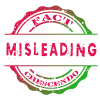
Hocco Ice Cream, one of the most known brands, had recently been trending on the social media when users started accusing that the brand uses harmful ingredients in its products. Some of the ingredients mentioned are INS 102, INS 110, INS 124, INS 476 and Palm Oil.
Users are claiming that the above-mentioned ingredients are harmful and lead to serious health issues like cancer, kidney issues, liver enlargement, hyperactivity etc.
However, Fact Crescendo found the claim to be misleading. All the ingredients in Hocco Aamchi Ice Cream meet safety standards and are safe when consumed within prescribed limits.
INS 102- INS 102 is also known as Yellow 5 or Tartrazine internationally. Its European Union Code is E102. According to a study conducted in 2015, researchers found that food with Yellow 5 as an ingredient damages the DNA of white blood cells. It was also found that since gastrointestinal tracts are exposed directly to yellow 5, these cells may be more likely to develop cancer.
FDA and top researchers have reviewed the evidence and concluded that yellow 5 doesn’t pose an immediate threat to human health. However, research does suggest that this dye may harm cells over time, especially when cells are exposed to greater amounts than the recommended intake.
The EFSA reviewed the safety of Tartrazine, a yellow food dye used in many products. Older studies showed that only a tiny amount of Tartrazine is absorbed by the body, while most of it is broken down by gut bacteria and leaves the body in urine. An acceptable daily intake (ADI) of 7.5 mg per kg of body weight was set many years ago, but the studies used were not detailed enough or focused on mixtures of dyes instead of just Tartrazine. Because of this, EFSA advised for more research to fully understand if Tartrazine is safe and if the ADI needs to be updated.
FDA has also approved the use of Yellow 5 in confections, cereals, snack foods, condiments, baked goods and yogurt.
INS 110 – This is also known as Sunset Yellow or Yellow 6 or E110. It is an orange-yellow dye that is used in candy, sauces, baked goods and preserved fruits. The European Food Safety Authority (EFSA) has set a new Acceptable Daily Intake (ADI) of 4 mg per kg of body weight per day for the food colouring Sunset Yellow. Previously, in 2009, EFSA had set a temporary ADI of 1 mg/kg due to limited data and recommended further studies. With new scientific data now available, EFSA has increased the ADI, confirming Sunset Yellow’s safety at the new updated level.
INS 124: This additive is also known as Ponceau 4R or Cochineal Red A or E124.
The European Food Safety Authority (EFSA) reviewed the safety of Ponceau 4R, a red food dye used in the EU, to see if people, especially kids might be consuming too much of it. A previous review in 2013 had reduced the amount that could be used. In a recent review, EFSA used updated data to see how much people are actually consuming. The results showed that even in the highest exposure cases, people, including toddlers and children were still eating less than the daily safe limit of 0.7mg per kg of body weight per day. So, the dye is considered safe at the levels currently used in food.
FDA had warned that Ponceau 4R or INS 124 color additive along with a few others had not been listed by the organization for use in food products in the United States. But these color additives are approved in other countries.
Palm Oil: The U.S. Food and Drug Administration had found that during high temperature refining of palm oils two contaminants 3-MCPD esters and glycidyl esters can form. These substances are considered harmful to the kidney and have potential link cancer. The FDA is actively researching these contaminants to better understand their occurrence in foods and to develop methods for reducing their levels during oil processing.
Palm oil is approved for use in food. The FDA recommended the manufacturers to minimize the presence of these contaminants to ensure safety of the consumers.
INS 476: This additive is also known as Polyglycerol Polyricinoleate (PGPR) or E476. It is used as an emulsifier in many foods. This additive is often derived from castor oil, not palm oil. The EFSA re-evaluated the E 476 to address gaps found in previous review. The assessment looked at the proposed use in new foods like ice cream and higher amounts in emulsified sauces. EFSA concluded that these changes would not pose any safety concerns.
EFSA also assessed potential harmful impurities in E 476 and recommended lowering the allowed levels of toxic elements such as arsenic, lead, mercury, and cadmium based on current commercial samples.
Conclusion:
Fact Crescendo found the claim to be misleading. All ingredients in Hocco Aamchi ice cream meets safety standards and are safe when consumed within prescribed limits.

Title:All Ingredients of Hocco Ice Cream Meets Safety Standards. The Product Is Safe To Consume.
Fact Check By: Siddharth SahuResult: Misleading


